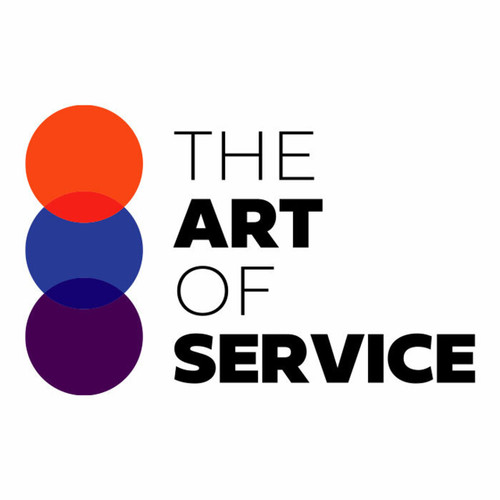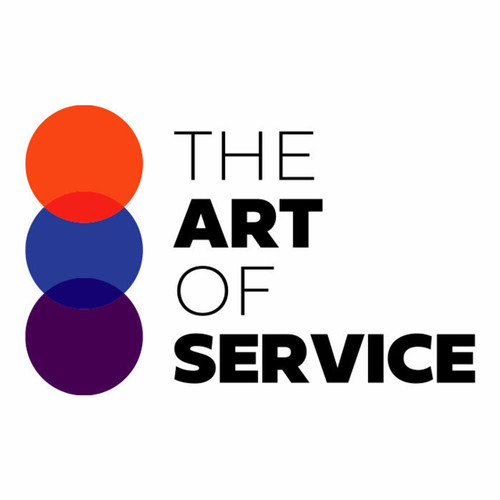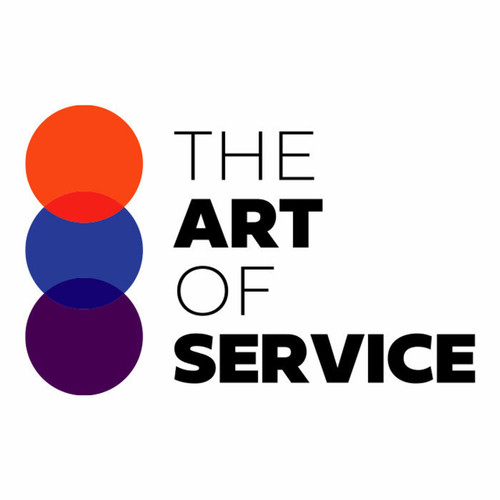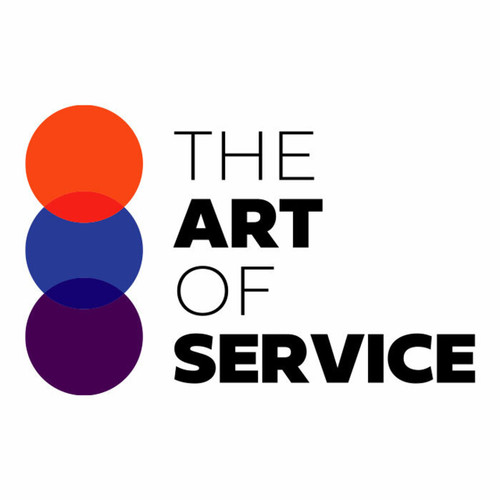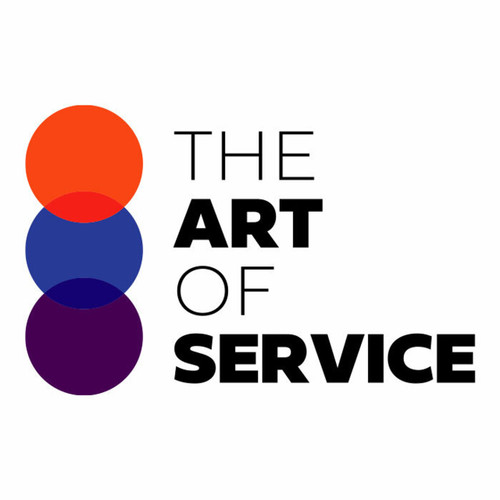Are you tired of spending endless hours searching for the most important questions to ask in order to get the best results for your business? Look no further!
Our Factory Automation and Semiconductor Equipment Manufacturer Knowledge Base is the solution you′ve been searching for.
Our Knowledge Base contains a carefully curated list of 1500 prioritized requirements, solutions, benefits, and results specifically tailored to meet the urgent needs and scope of your industry.
This invaluable dataset also includes real-life case studies and use cases to further enhance your understanding and application of the information.
But what sets our Knowledge Base apart from competitors and alternatives? Our product is designed by professionals, for professionals, ensuring that it meets the highest standards of accuracy and relevance.
It is also incredibly user-friendly, making it easy for anyone to navigate and utilize its wealth of knowledge.
And with its affordability, it serves as a practical DIY alternative to costly consulting services.
With our Factory Automation and Semiconductor Equipment Manufacturer Knowledge Base, you′ll have all the crucial details and specifications at your fingertips.
You′ll gain a better understanding of how our product compares to semi-related types, and the vast array of benefits it offers.
Plus, with thorough research on the industry, you can trust that our Knowledge Base is reliable and up-to-date.
Not only is our product beneficial for individual professionals, but it also caters to the needs of businesses.
Its cost-effective nature makes it a wise investment for companies of any size, providing them with the necessary tools for success.
So why wait? Say goodbye to endless searching and guesswork, and hello to reliable and comprehensive information.
Our Factory Automation and Semiconductor Equipment Manufacturer Knowledge Base has got you covered.
Get your hands on it today and see the difference it can make for your business.
Discover Insights, Make Informed Decisions, and Stay Ahead of the Curve:
Key Features:
Comprehensive set of 1500 prioritized Factory Automation requirements. - Extensive coverage of 76 Factory Automation topic scopes.
- In-depth analysis of 76 Factory Automation step-by-step solutions, benefits, BHAGs.
- Detailed examination of 76 Factory Automation case studies and use cases.
- Digital download upon purchase.
- Enjoy lifetime document updates included with your purchase.
- Benefit from a fully editable and customizable Excel format.
- Trusted and utilized by over 10,000 organizations.
- Covering: Packaging Tools, Production Efficiency, Equipment Downtime, Automation Solutions, Automated Manufacturing, Wire Bonding, Assembly Machines, Process Optimization, Factory Automation, Automation Solutions Provider, Packaging Solutions, Integrated Circuits, Quality Assurance, Quality Assurance Tools, Cost Effective Solutions, Semiconductor Shortage, Expanding Markets, Technological Advancements, Advanced Diagnostics, Cleanroom Equipment, Forecast Accuracy, Productivity Enhancements, Materials Handling, Customized Solutions, Test And Measurement, Device Packaging, Critical Cleaning, Factory Design, High Volume Production, Process Control Systems, Precision Engineering, Packaging Materials, Product Inspection, Machine Tools, Chemical Processing, Qualification Tests, Robotics Technology, Production Machinery, Process Monitoring, Mask Inspection, Process Control, Precise Positioning, Testing Equipment, Process Monitoring Systems, Back End Processing, Machine Vision Systems, Metrology Solutions, Equipment Upgrades, Surface Preparation, Fabrication Methods, Fab Automation, Deposition Techniques, Materials Science, Defect Detection, Material Handling Systems, Environmental Controls, Semiconductor Development, Semiconductor Equipment Manufacturer, Material Science, Product Development, Equipment Repair, Chip Testing, Quality Control, Equipment Maintenance, Semiconductor Industry, Diffusion Technology, Environmental Controls Systems, Assembly Lines, Image Processing, High Performance Materials, Demand Aggregation, Converting Equipment, Gas Abatement, Inspection Solutions, Failure Analysis, Laser Processing
Factory Automation Assessment Dataset - Utilization, Solutions, Advantages, BHAG (Big Hairy Audacious Goal):
Factory Automation
Factory automation is the use of technology and machinery to increase efficiency and reduce human labor in manufacturing processes. The organization is likely planning to cover areas such as quality control, production scheduling, and inventory management with strategic control points.
1. Implementing a centralized control system for improved monitoring and coordination of operation.
Benefits: Increases efficiency, reduces errors, and streamlines processes for better overall production.
2. Integrating smart sensors to collect and analyze data in real-time for predictive maintenance.
Benefits: Reduces downtime, increases equipment lifespan, and lowers maintenance costs.
3. Introducing automated material handling systems for faster and more accurate material movement.
Benefits: Improves overall equipment effectiveness, reduces material waste, and increases productivity.
4. Adopting robotic automation for repetitive and hazardous tasks, freeing up employees for more skilled work.
Benefits: Improves worker safety, increases productivity, and reduces labor costs.
5. Incorporating machine learning and artificial intelligence technologies for intelligent decision making.
Benefits: Enhances process control and optimization, improves product quality, and reduces production defects.
6. Implementing cloud-based solutions for remote monitoring and remote access to equipment and data.
Benefits: Enables real-time monitoring and control, facilitates data analysis for process improvement, and increases flexibility.
7. Utilizing virtual reality and augmented reality for training and troubleshooting purposes.
Benefits: Improves employee training efficiency, reduces errors in operation and maintenance, and speeds up troubleshooting processes.
8. Developing a robust cybersecurity plan to protect sensitive data and prevent hacking or cyber attacks.
Benefits: Protects intellectual property, maintains data integrity, and ensures reliable and secure operation of equipment.
CONTROL QUESTION: What strategic control points is the organization planning to cover in the future?
Big Hairy Audacious Goal (BHAG) for 10 years from now:
The big hairy audacious goal for Factory Automation 10 years from now is to be the market leader in innovative and sustainable factory automation solutions, globally recognized for revolutionizing the manufacturing industry. We will achieve this by continuously pushing the boundaries of technology and working closely with our clients to provide customized solutions that improve efficiency, productivity, and sustainability within their factories.
To ensure the success of this goal, our organization will focus on the following strategic control points:
1. Advanced Robotics: Our goal is to incorporate cutting-edge robotics technology into our automation solutions, enabling factories to seamlessly integrate human and machine tasks. This will not only increase efficiency but also create a safer work environment for employees.
2. Internet of Things (IoT): By leveraging the power of IoT, our goal is to enable real-time communication and coordination between different machines and systems within a factory. This will result in optimized production processes, reduced downtime, and improved overall performance.
3. Artificial Intelligence (AI): Our aim is to implement AI algorithms into our automation solutions, allowing factories to make data-driven decisions, anticipate potential issues, and optimize their operations continuously. This will lead to increased efficiency, improved quality control, and higher productivity.
4. Sustainability: As global concerns for the environment continue to grow, our goal is to develop fully sustainable automation solutions. This will involve incorporating renewable energy sources, reducing waste, and promoting sustainable practices within the industry.
5. Global Expansion: To achieve our goal of becoming a global leader in factory automation, we plan to expand our operations to new markets. We will establish partnerships and collaborations with local companies to gain a foothold in different regions and cater to the specific needs of each market.
6. Continuous Innovation: In an ever-evolving technological landscape, our organization will continue to prioritize research and development to stay ahead of the curve. We will constantly innovate and enhance our solutions to provide the best possible automation experience for our clients.
7. Talent Development: To support our ambitious goal, we will invest in talent development programs to attract and retain top talent in the field of automation. We will also provide ongoing training and skills development opportunities to ensure that our team remains at the forefront of industry advancements.
By covering these strategic control points, we are confident that we will achieve our big hairy audacious goal and solidify our position as the leader in factory automation. Our commitment to innovation, sustainability, and talent development will drive us towards revolutionizing the manufacturing industry and setting new standards for automation excellence.
Customer Testimonials:
"I can`t express how pleased I am with this dataset. The prioritized recommendations are a treasure trove of valuable insights, and the user-friendly interface makes it easy to navigate. Highly recommended!"
"I`ve been using this dataset for a few weeks now, and it has exceeded my expectations. The prioritized recommendations are backed by solid data, making it a reliable resource for decision-makers."
"The range of variables in this dataset is fantastic. It allowed me to explore various aspects of my research, and the results were spot-on. Great resource!"
Factory Automation Case Study/Use Case example - How to use:
Client Situation:
XYZ Company is a leading manufacturer of industrial machinery and equipment, operating in the highly competitive market of Factory Automation. The company has been in business for over three decades and has established itself as a market leader through innovation and high-quality products. However, with the increasing competition and changing market dynamics, the organization is facing several challenges in maintaining its market share and profitability.
To address these challenges and stay ahead of the competition, XYZ Company has decided to invest in strategic control points to streamline its processes, enhance efficiency, and improve overall performance. The organization has sought the help of consulting firm ABC to identify these control points and develop a comprehensive plan for their implementation.
Consulting Methodology:
The consulting approach followed by ABC was based on a thorough understanding of the client′s business, market, and competitive landscape. The team conducted in-depth interviews with key stakeholders, including top management, operations managers, and other relevant personnel, to identify pain points and areas of improvement. The consultants also analyzed the company′s financial data, market trends, and industry reports to gain a holistic view of the business and its challenges.
Based on the findings, ABC developed a customized approach that focused on identifying strategic control points that would provide the most impact to the organization′s performance. The methodology involved the following steps:
1. Identification of Key Processes:
The first step was to identify the key processes of the organization that contribute to its overall performance. This included operational and administrative processes, such as supply chain management, production, quality control, and sales and marketing.
2. Process Mapping:
The team then conducted a process mapping exercise to understand how these processes were currently being carried out and to identify any bottlenecks or inefficiencies.
3. Gap Analysis:
Once the processes were mapped, a gap analysis was conducted to compare the current state of operations with the desired state. This helped in identifying the areas that needed improvement and provided a baseline for measuring the success of the strategic control points.
4. Identification of Strategic Control Points:
Based on the gap analysis, the consultants identified strategic control points that would have the most significant impact on the organization′s performance. These control points were selected based on their potential to streamline processes, reduce costs, and improve overall efficiency.
5. Development of Implementation Plan:
Once the strategic control points were identified, a detailed implementation plan was developed. The plan included timelines, resource allocation, and key performance indicators (KPIs) for measuring the success of each control point.
Deliverables:
The consulting firm delivered a comprehensive report outlining the findings of the assessment, along with a detailed implementation plan for the identified control points. The report also included a cost-benefit analysis, risk assessment, and recommendations for future actions.
Implementation Challenges:
The implementation of strategic control points in an organization is often a complex and challenging process. Some of the challenges faced during the implementation of the plan included:
1. Resistance to Change:
Implementing new processes and systems often faces resistance from employees who are used to working in a certain way. It was essential to communicate the benefits of the changes and involve employees in the process to overcome this challenge.
2. Integration with Existing Systems:
Introducing new processes and systems need to be integrated seamlessly with the existing ones to ensure smooth operations. This required coordination between different departments and careful planning to avoid disruptions.
3. Cost Considerations:
Implementing strategic control points requires investment in new technology, training, and other resources. Cost considerations were carefully evaluated to ensure a positive return on investment.
Key Performance Indicators (KPIs):
The implementation of strategic control points was closely monitored using KPIs developed for each control point. The KPIs included measures such as reduction in lead time, improvement in productivity, reduction in costs, and increase in customer satisfaction.
Management Considerations:
To ensure the successful implementation and sustainability of the strategic control points, management at XYZ Company took the following actions:
1. Allocation of Resources:
The organization allocated necessary resources and budget for implementing the strategic control points as per the recommendations provided by the consulting team.
2. Training and Development:
To prepare employees for the changes, training and development programs were conducted to enhance their skills and knowledge.
3. Continuous Monitoring:
Management regularly monitored the implementation progress, identified any issues, and took corrective actions to ensure the success of the project.
Conclusion:
The strategic control points identified and implemented by XYZ Company in collaboration with the consulting firm ABC helped the organization in streamlining its processes, reducing costs, and improving overall efficiency. The company was able to achieve a significant increase in productivity and customer satisfaction while maintaining its market leadership position. This case study highlights the importance of continuously evaluating and improving processes to stay competitive in the dynamic market of Factory Automation.
Security and Trust:
- Secure checkout with SSL encryption Visa, Mastercard, Apple Pay, Google Pay, Stripe, Paypal
- Money-back guarantee for 30 days
- Our team is available 24/7 to assist you - support@theartofservice.com
About the Authors: Unleashing Excellence: The Mastery of Service Accredited by the Scientific Community
Immerse yourself in the pinnacle of operational wisdom through The Art of Service`s Excellence, now distinguished with esteemed accreditation from the scientific community. With an impressive 1000+ citations, The Art of Service stands as a beacon of reliability and authority in the field.Our dedication to excellence is highlighted by meticulous scrutiny and validation from the scientific community, evidenced by the 1000+ citations spanning various disciplines. Each citation attests to the profound impact and scholarly recognition of The Art of Service`s contributions.
Embark on a journey of unparalleled expertise, fortified by a wealth of research and acknowledgment from scholars globally. Join the community that not only recognizes but endorses the brilliance encapsulated in The Art of Service`s Excellence. Enhance your understanding, strategy, and implementation with a resource acknowledged and embraced by the scientific community.
Embrace excellence. Embrace The Art of Service.
Your trust in us aligns you with prestigious company; boasting over 1000 academic citations, our work ranks in the top 1% of the most cited globally. Explore our scholarly contributions at: https://scholar.google.com/scholar?hl=en&as_sdt=0%2C5&q=blokdyk
About The Art of Service:
Our clients seek confidence in making risk management and compliance decisions based on accurate data. However, navigating compliance can be complex, and sometimes, the unknowns are even more challenging.
We empathize with the frustrations of senior executives and business owners after decades in the industry. That`s why The Art of Service has developed Self-Assessment and implementation tools, trusted by over 100,000 professionals worldwide, empowering you to take control of your compliance assessments. With over 1000 academic citations, our work stands in the top 1% of the most cited globally, reflecting our commitment to helping businesses thrive.
Founders:
Gerard Blokdyk
LinkedIn: https://www.linkedin.com/in/gerardblokdijk/
Ivanka Menken
LinkedIn: https://www.linkedin.com/in/ivankamenken/

